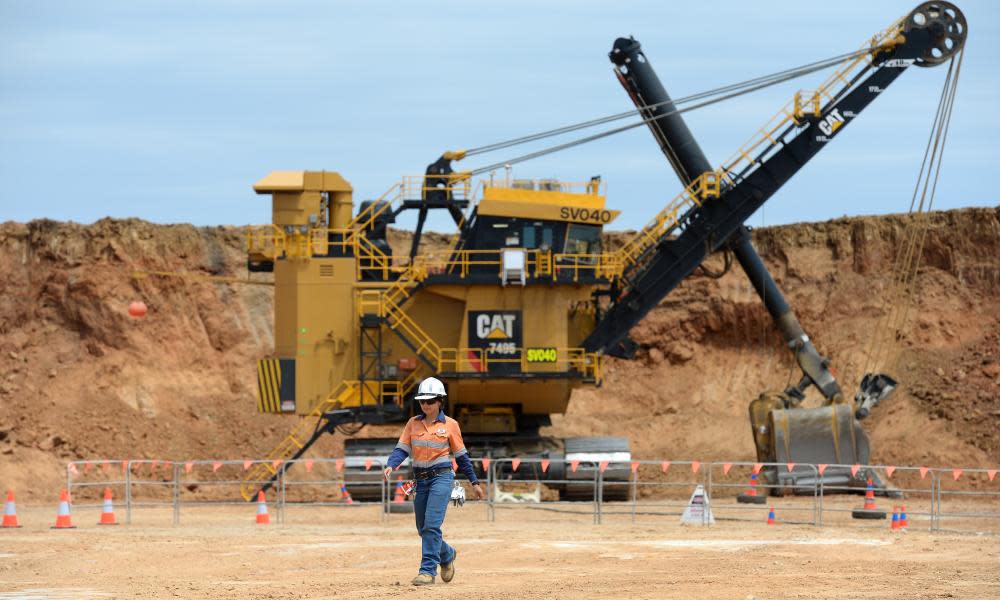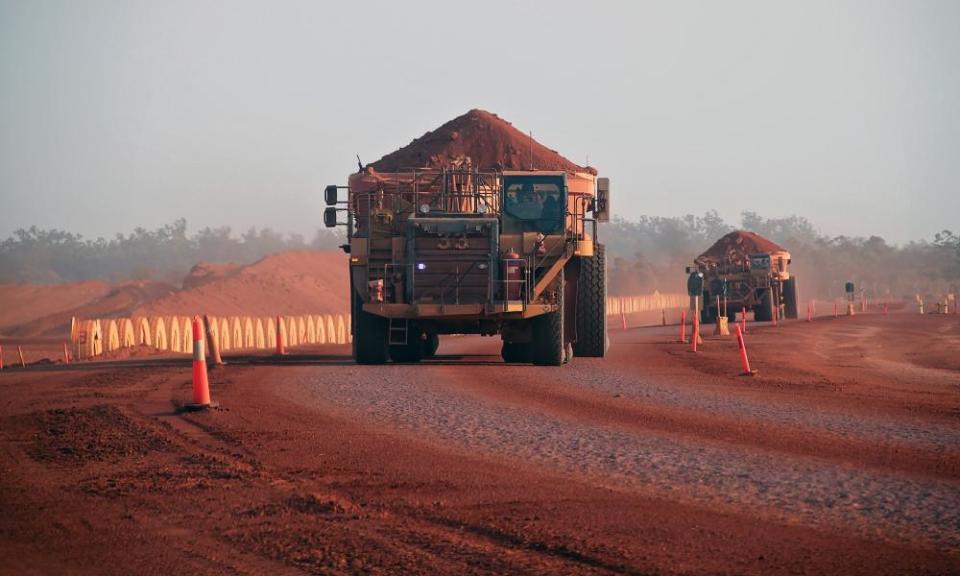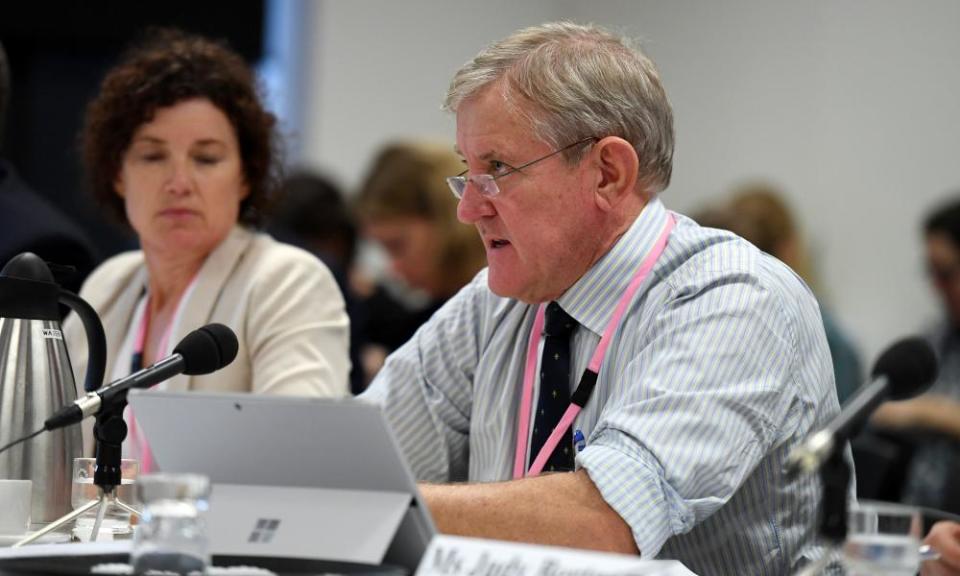Queensland election: why the resources council's jobs figures don't pass 'the laugh test'

In a radio advert, the script is unambiguous: “The resources sector employs 372,000 Queenslanders.”
Queensland’s mining lobby, the Queensland Resources Council (QRC), is running the adverts as part of a campaign to encourage voters to back candidates that will “protect your job” and support its industry.
Except the jobs claims, according to official data, are massively inflated and the method used to make them, experts have told Guardian Australia, are questionable.
“It’s a bogus number,” says Prof John Quiggin, an economist at the University of Queensland.
Queensland’s powerful mining lobby, which rejected the criticisms, is running two election campaigns as it tries to gain political support for a “resource industry recovery agenda” that asks for almost $1bn in government investment.
Having a message out there that the industry is responsible for about one in six of all jobs can only help their cause.
But according to latest Australian Bureau of Statistics labour force figures, only 66,000 Queenslanders work in mining compared with 79,000 in agriculture, forestry and fishing; 50,000 in arts and recreation; and 160,000 in manufacturing.
The Queensland government’s health department employs about 90,000 people.
QRC’s own commissioned research that underpins its jobs claims says its members directly employ 36,644 full-time workers. So how does the council get from 36,644 full-time workers to the massive 372,000 jobs being claimed in its political advertising?
This estimate is the biggest stretch I have ever seen.
Prof John Quiggin
“Easy,” says Richard Denniss, the chief economist at progressive thinktank the Australia Institute. “You multiply a small number by a big number.”
The QRC’s report that underpins its jobs claims says “Input-Output” modelling and then multipliers are used to capture how spending flows into other parts of the economy. The report says the approach is “solid” and an “appropriate tool”.
Dennis says one example of the questionable jobs claims can be found in the inner-city Brisbane electorate of McConnel, where QRC says it has 1,000 full-time employees.
After the modelling and multipliers, QRC claims the “total economic contribution to McConnel” includes 46,750 full-time jobs in the electorate.
But the Electoral Commission of Queensland says McConnel has just 39,212 enrolled voters.
“This is why this stuff is silly,” Dennis says.
Quiggin says Australia’s Bureau of Statistics has warned against using the modelling approach because, the ABS says, it has “inherent shortcomings” that make it “inappropriate for economic impact analysis”.
“It doesn’t pass the laugh test and has been thoroughly repudiated by the ABS,” he told Guardian Australia, saying it was able to make an industry appear as large as a modeller wanted.
“This estimate is the biggest stretch I have ever seen,” he said, adding if it was applied across all sectors it would imply the Queensland economy employs around 10 million people. Australia’s total workforce is 12.5m.
Denniss is a long-time critic of the method and has publicly criticised the mining industry for using the approach.
“These multipliers have no role in any sensible debate about employment,” he says. “The consequences of using them are to generate silly number.”
He said if every industry in Queensland used the same modelling to make claims about employment, the total number of jobs would be several times higher than the state’s entire labour force.
The QRC’s members include some of the biggest mining and resources companies in Australia and the world, such as Rio Tinto, Shell, Peabody, Origin and Glencore.

QRC is led by former federal resources and industry minister Ian Macfarlane, who spent 14 years as a minister under John Howard and later Tony Abbott and Malcolm Turnbull.
Launching the Protect Your Job campaign earlier this week, Macfarlane said the claimed 372,000 jobs “highlights the need for people to vote for candidates who support jobs in the Queensland resources sector”.
He said: “Our industry is well positioned to keep doing the heavy lifting for the state economy, but we need the next Queensland government to be ready to work hand-in-hand with our coal, metals and gas companies to bring new projects and new jobs online as a top priority.”
QRC is running radio adverts, digital banners and has hired a billboard “to reach voters in targeted Queensland seats.”
On Facebook, QRC has spent about $8,000 advertising the campaign that has been seen about 800,000 times on people’s Facebook pages.
The campaign is the second major Queensland election effort launched by the QRC, which is also urging Queenslanders to “put Greens last” on their ballot paper.
That campaign caused two of the council’s high-profile members, BHP and Origin, to suspend their memberships, with other members expressing concern.
The QRC’s “resource industry recovery agenda” is asking for about $964m of government backing, including $14.8m for a high-voltage transmission line to connect a minerals province that would also “unlock some of Queensland’s most prospective renewable energy generation sites.”
The QRC also wants $500m for pipeline infrastructure, $50m for road bottlenecks and $100m over four years to help them search for more resources.

Denniss argues the mining industry’s claims about jobs are not to directly influence the vote of the public, but to shore up support from whichever government gets in.
“It’s about giving the political class the excuse it needs to hand taxpayer money to a very small employer,” he says. “Not all industries get a lot of government support.”
“In exchange for an enormous amount of taxpayer subsidy, the mining industry spends millions providing a cover story for the politicians that support the subsidies. Otherwise, the public would be left with the question of why you give so much money to such a small employer. The whole thing is a cover story.
“In a democracy, power is the ability to talk bullshit and then get away with it.”
The Productivity Commission has also warned more broadly of the “uses and abuses” of the modelling approach across many sectors, Quiggin says.
A 2013 Productivity Commission report was critical saying while the modelling was useful in some cases “abuse primarily relates to overstating the economic importance of specific sectoral or regional activities”.
The report said “claims that jobs ‘gained’ directly from the cause being promoted will lead to cascading gains in the wider economy” were problematic and could “misinform policy-makers.”
In a response to questions from Guardian Australia, QRC said environmentalists had been “very selective misquoting of what the commission said” and quoted a subsequent paragraph from the commission report that said the approach “may be extremely useful in economic analysis.”
QRC said the quality of the modelling was “greatly increased by the quality of our measured data” and was detailed enough to link jobs and spending to postcodes, “which means the model can be similarly precise.”
QRC said it measured direct employment but modelled indirect employment.
“Like all Queenslanders, we know jobs at the mine site are supported by people off-site in a range of technical and professionals roles within the company itself, joint venture partners, suppliers and specialist contractors and professional services.”
QRC said in McConnel, more people worked there than lived there and the “strong presence of the resources sector is evident from the number of companies based in the city and indeed the number of office buildings adorned with their logos.
“While their jobs, like the staff of QRC, may be in McConnel; they will be registered to vote where they live across south-east Queensland and further afield.”


